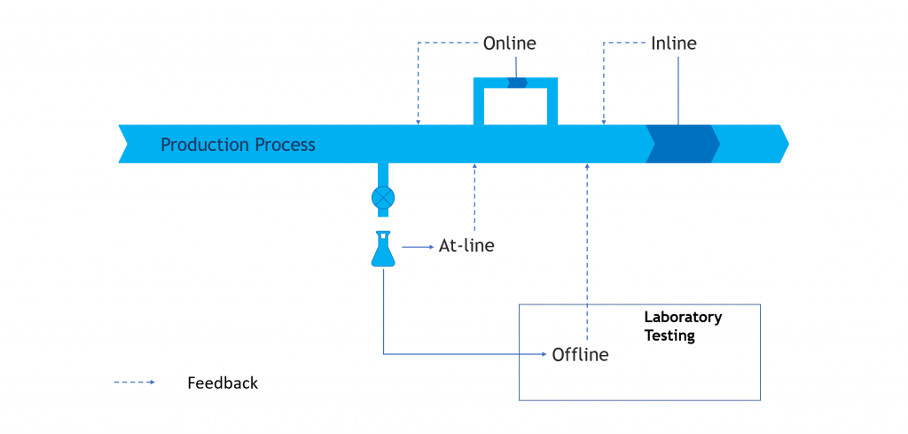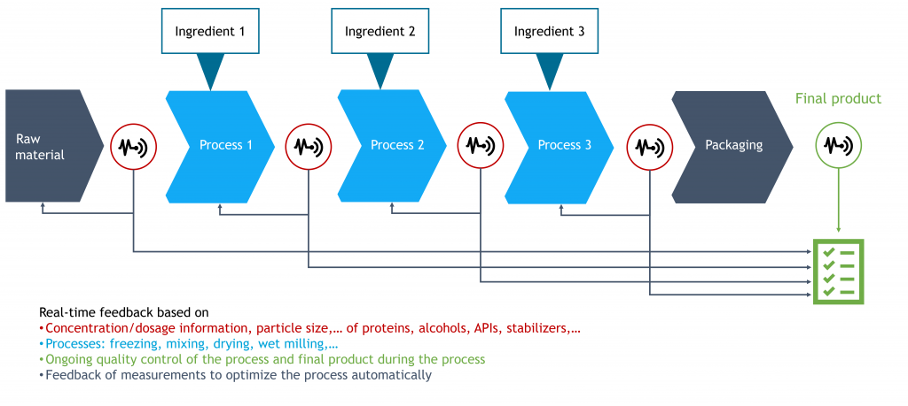Different types of process analysis
Variations in raw materials or external factors may result in unwanted effects on the product quality. Regular or continuous process monitoring is critical to ensure the quality standards are met and maintained. There is an ongoing trend from offline or at-line analysis (laboratory based) towards online and inline measurements (sensor based).

Different approaches for quality control in production processes.
- Offline analysis is done in the lab. This approach is characterized by manual sampling, discontinuous sample preparation, measurements and evaluation. The product parameters might change during the time between sampling, measurements and evaluation. The delay between sampling and available results prevents direct process control. It is expensive and lets room for errors while there is no constant monitoring.
- Atline analysis is still conducted on the fabrication floor but requires sampling and sample preparation before analysis. These measurements are time-consuming making direct process control very limited.
- Online analysis is achieved via a bypass. The analyzers continuously monitor a representative part of the total process stream. In most cases, the product travels via the bypass to be analyzed by the sensor and returns back to the system. However, several online sensors use destructive testing due to labeling or chemical reactions. These systems are based on automatic sampling and sample preparation followed by destructive testing. The latter approach is less favorable since a part of the product is lost. Online analysis allows (quasi-) real-time feedback and process control.
- Inline analysis consists of continuously analyzing the products within the production process. The sensors can be installed on a conveyor belt for solid products or integrated in pipes or vessel for liquid products. This approach has the advantage that all products or material are analyzed in real time which facilitates direct process control.
This method allows constant optimizing of the production parameters. Results could be less energy consumption, higher throughput and the constant required quality.
How does it work?
Various analysis techniques (e.g. thermogravimetric analysis, Karl Fisher) cannot be applied directly to the production process. The reasons vary from the need of sample preparation, limited measurement range, or interference effects with certain elements in the product. Moreover, analysis methods which only evaluate a part or the surface of the material e.g. infrared spectroscopy, never give the full picture as they do not measure the inside.

Inline quality control using Aquantis sensors
The world moves to more and reliable digitization in processes, also production processes. Reasons include legislation, the where-abouts of a product in the production chain, …, peace in mind. Aquantis’ well-tested inline measurement solutions are based on micro- and millimeter waves and can be combined with the test facilities you have already. This technology has a unique set of characteristics which includes nondestructive behavior, flexible penetration depth, large measurement range, no need of sample preparation and real-time data. This makes our sensing technology widely applicable to various industrial processes and materials.
The Aquantis sensors can be installed and integrated in the various steps of the production process. This flexibility is the result of the combination of hardware components and Artificial Intelligence software.
Conclusion
The ongoing trend towards automated process control requires a shift in process analysis. While offline and atline analyses are based on time-consuming sampling and discontinuous evaluation, inline and online analyses are directly incorporated within the production process and close to non-human dependency. This enables 24/7 real-time and direct process control. However, many of the existing analysis techniques cannot be used as inline or online sensors. Therefore, Aquantis develops new inline digitized measurements solutions to obtain consistent real-time quality and process control.